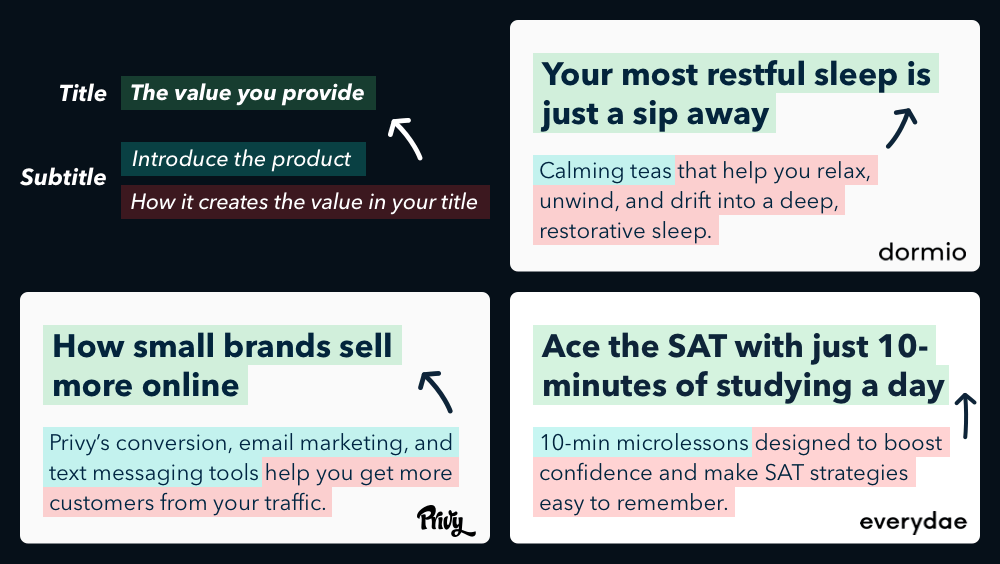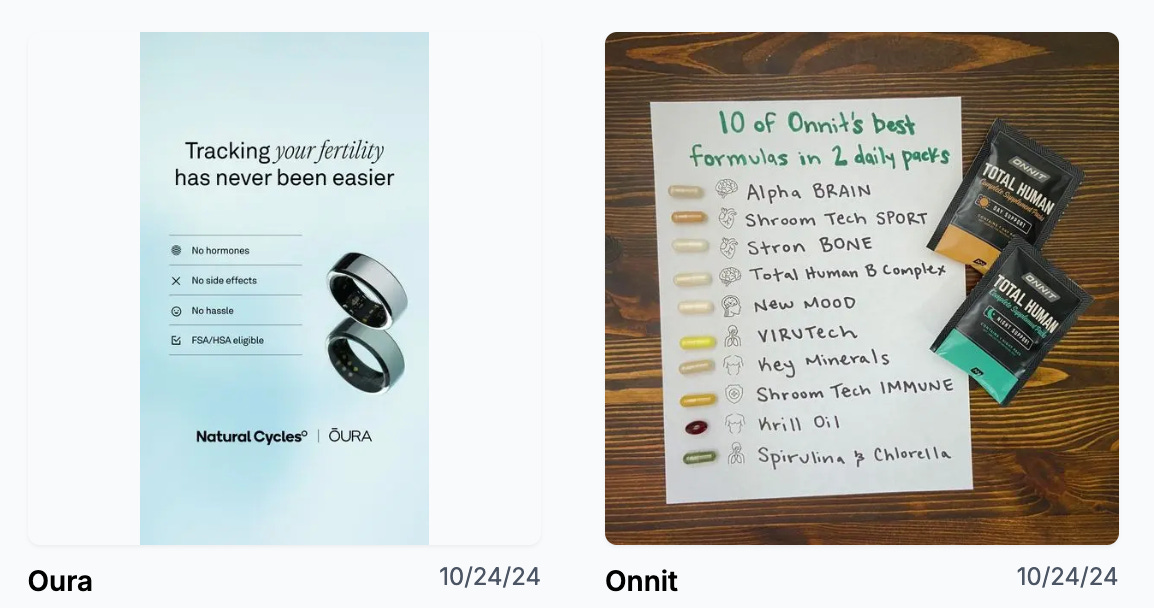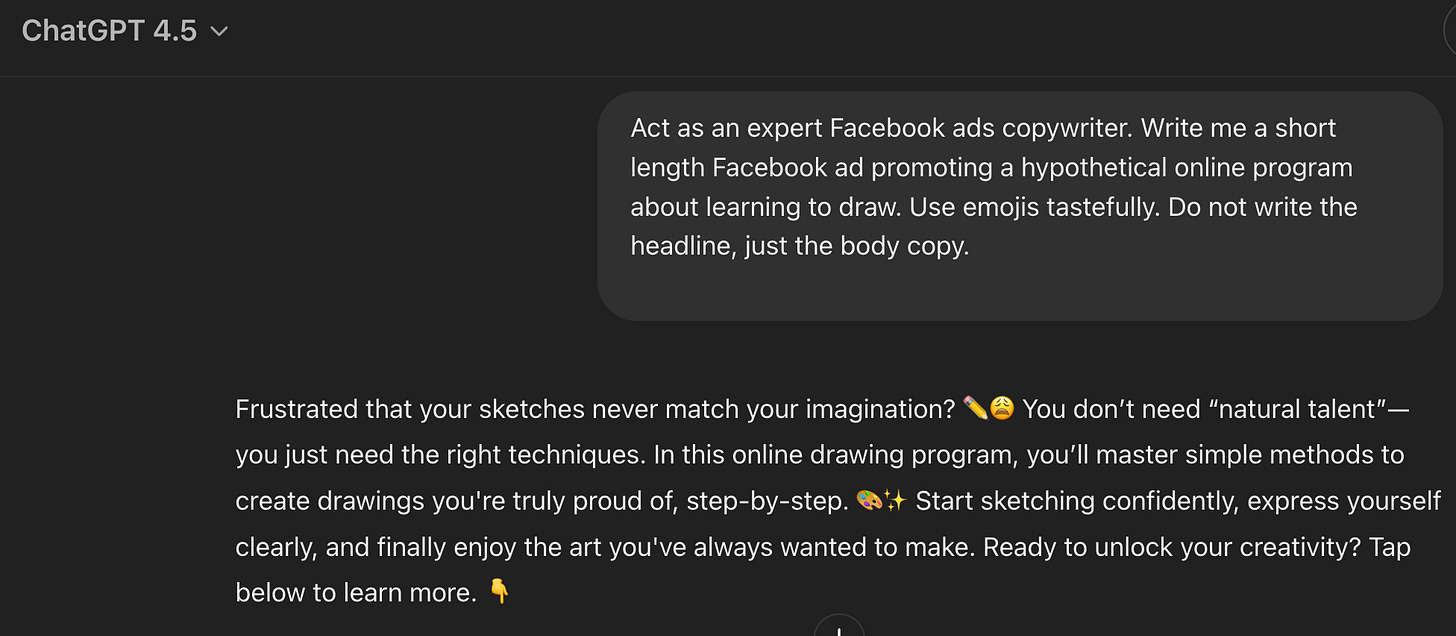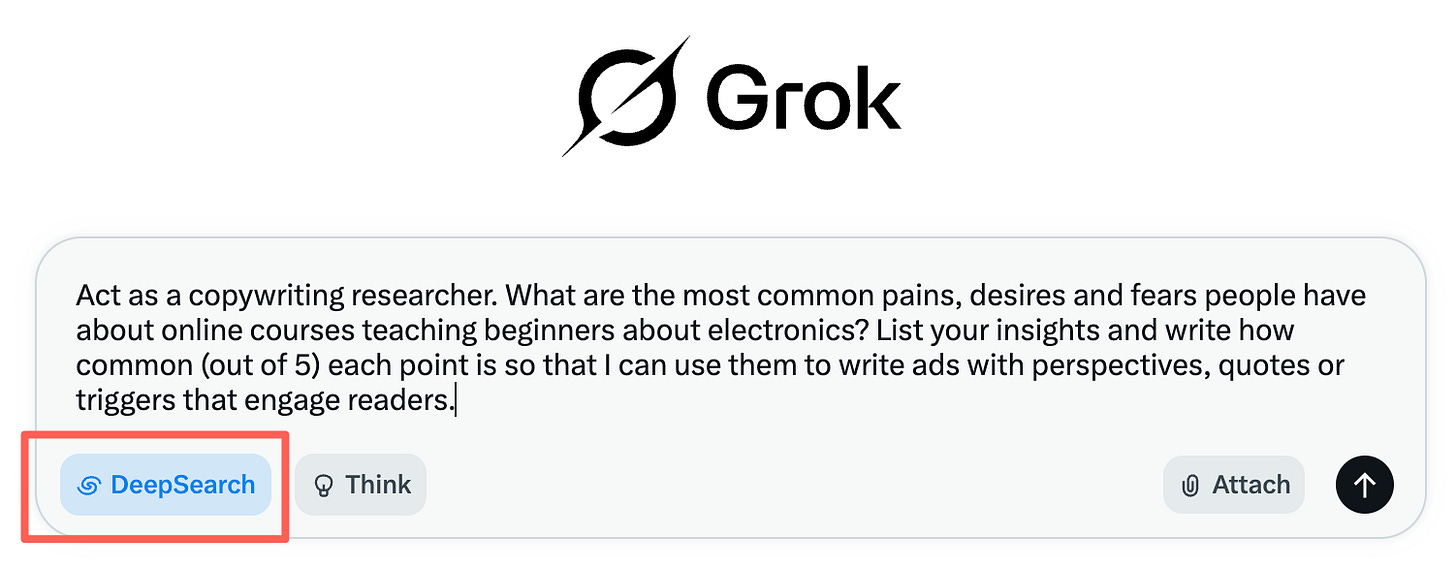How to Write Copy For Facebook Lead Ads (Incl. using AI)
Most people start out writing Facebook ads by looking up and referencing their competitors on the Meta Ads library.
The problems with this is:
Their copy might be a bit crap, because you can’t see their stats.
You don’t know what elements/angles they tried before.
If it works, you don’t know why, so you can’t iterate the performance.
So over time, I’ve developed a process for writing ad copy that I think most people can copy that will improve your ad copy quality, even without being a creative genius.
The Steps
As an overview, here’s how I do it for a standard static image or video ad particularly for lead generation:
Pick an awareness stage. There are 5 awareness stages, this will direct how you write copy.
Research. I find reviews for the brand or relevant competitors. If not, you can always use tools like Perplexity to reference Reddit sentiment.
Messaging. Pick your messaging angles, which is the positioning of your ad. You need multiple to test.
Appeals & Emotions. Work out the way you’ll express that message to get people interested together with the emotional transformation you want people to have.
Body copy hooks. Write the hooks for your main body copy separately as these are the 80/20
Body copy. Write the body copy the appropriate copywriting formulas such that they link with any body hook, but also can be tested against each other. E.g. Pain Agitate Solution (PAS) vs Before After Bridge (BAB).
Creative headlines. Create Headlines for your creatives that communicate a clear offer, make a big promise, are relatable or intrigue further reading.
Ad headlines. These headlines can be more to the point and super clear. A big promise, a curiosity hook or just the jazzed-up offer.
Descriptions. While I often skip this part of the ad unit, when I do write them, I make them like a sub-headline on a landing page. Describe how you’ll achieve the ad headline or give supporting information.
Supporting copy (dot points). These go on your creatives and in your forms. I do two sets, features and benefits so that I can test both.
Let me go through each in detail.
Just quickly, which AI to use for Facebook Ad Copywriting?
Pick whatever you like, really, I think they can all generally do the job with enough prompting and tweaking.
But if I had to narrow it down to two, I’d suggest focusing on Claude and Chat GPT, with Claude (as of March 2025) has the edge in writing more natural copy.
Examples from both with a simple prompt:
Act as an expert Facebook ads copywriter. Write me a short length Facebook ad promoting a hypothetical online program about learning to draw. Use emojis tastefully. Do not write the headline, just the body copy.Claude Sonnet 3.7
Chat GPT 4.5
Grok 3
Out of the box you can see Claude is possibly the closest to being usable.
1. Pick An Awareness Stage
Without picking an awareness stage, for me, it’s a little unclear what the copy is trying to achieve in context. Is it simply trying to be interesting? Convince people? Prove something?

The 5 awareness stages represent different levels of… awareness, about the product or service that a customer may be in.
Picking one gives direction to the copy. This example from feloncholy on Reddit (link) gives a good summary on how you would write differently for each stage:
As you can see, writing for someone who’s unaware of the problem your product solves is completely different to someone who’s already aware of other solutions.
So if you were promoting say, an Improve Your Drawing program, to a totally cold audience it makes sense to target the problem aware stage folks knowing that you probably don’t have much audience to retarget down in the product/most aware stages.
2. Do Customer Research
Now that we have the awareness stage identified, we can do research to ‘get into the mind’ of prospects.
What I’m looking for in this stage is to understand the real life pains, desires and fears that people have. I’m hunting for strategic quotes and data-backed (as much as possible) information on perspectives.
An easy source of collecting this information is looking at reviews.
Reviews are basically a discussion forum about what people think about a product or service. A goldmine, really.
Go to Google and search the brand or a competitor and scroll down to the bottom of their reviews so you can copy all of them in one selection.
Then I’ll dump these and dump them into an LLM and use that to digest and find common themes and insights.
Act as a copywriting researcher. What are the most common pains, desires and fears people have about the product/service according to the reviews I've included below? List your insights and write how common (out of 5) each point is so that I can use them to write ads with perspectives, quotes or triggers that engage readers.You can imagine, if this company was your client - these quotes would make awesome ad headlines, too.
You can get review information from anywhere. You can also use Perplexity or even Grok 3 for surveying the web or Reddit.
Act as a copywriting researcher. What are the most common pains, desires and fears people have about online courses teaching beginners about electronics? List your insights and write how common (out of 5) each point is so that I can use them to write ads with perspectives, quotes or triggers that engage readers.Results
Grok 3
Sometimes I think Grok is actually better at research than other tools like Chat GPT or Perplexity.
Results
As you go through your research, pop all of this into a doc so that you can reference it when you go to write the copy.
3. Pick a Messaging Angle
With the research done, we can pick our messaging angles, which is the positioning of your ad. Messaging angles can be something like:
For a drawing program, “The fastest way to get drawing your characters”.
For the carpet cleaner, “The on-call solution for even the messiest problems.”
I like to choose 2-3 to test a time in order to A/B test.
Use the research from the previous stage to find out which messaging angles most likely to be compelling to the audience. You’ll also have to think about what the product strengths are, to make sure it can deliver.
4. Create an Appeal or Emotional Transformation
Appeals aren’t talked about much in Facebook ad circles, but I think we should bring them back.
Appeals are archetypes of emotional arguments used to make the message more interesting. We’ve all seen or heard of common ones, like:
Sex appeal 🍆🍑
Authority “9 out of 10 dentists like this toothbrush.”
Bandwagon “All your friends are doing it. Why not you?”
etc.
Think through what appeal you can use to write the copy for each messaging angle.
Alternatively, you can identify what emotional transformations from negative → positive you want to use for each angle.
This is an idea I got from Nick Theriot.
Thinking through the emotional transformations you want to make in customers can add a more engaging sophistication to the ads.
This is copy without emotion:
“The fastest way to get draw your characters without”.
“The on-call solution for even the messiest problems.”
With emotional transformations:
“The fastest way to draw characters you love and finally break free from crippling perfectionism”.
“The on-call solution for even the messiest, embarrassing situations. We’ve got your back.”
You can use an emotion wheel to get ideas.

I like to pick 2 appeals or emotional transformations (the most likely ones) for each messaging angle so I can A/B test that aspect of the copy, too.
5. Write Body Copy Hooks
Ok, ok. Now we can finally get to do some writing.
First thing is to tackle the body copy hooks. This is the most important because when you see ads on Facebook you’re going to see the body hook first on both Facebook AND Instagram.
⚠️ Instagram doesn’t even show the ad unit headline. So it’s doubly important to use this hook as your headline.
There are a bunch of options here. You can make:
A curiosity or,
big benefit type hook.
You can also add an audience call out in front.
“Hey {suburb} gents!”
“This is the BEST way to get X without Y…”
Etc.
I’m a big fan of Andrew Hubbard’s advice (link) which is to play with the truncation on Instagram (see above) so that your hook makes sense even when cut off.
See where it says …more ? He means you should make sure that the beginning of your body copy hook makes sense before that … more cutoff.
Make each body hook aligns with your messaging and appeal/emotional transformation choices above.
6. Write the Body Copy
Now we can write the body copy. And rather than do it freestyle, I suggest using a formula. But there are many copywriting formulas to use, like:
Attention, interest, desire, action (AIDA)
Before, after, bridge (BAB)
Pain, agitate, solution (PAS)
Hook, story, offer (HSO)
etc.
And while my favourite all-rounder is AIDA, the truth of which one is best seems to be that it just depends. Every product and awareness level suits a different formula.
So typically I’ll pick one or two formulas I feel best suit the product/awareness stage and write from that framework.
Importantly, I’ll write the body copy such that any body hook we made previously can be used with it, so that the copy becomes modular.
{body hook 1, 2, 3…}
{body copy}This allows you to switch out multiple body hooks to test new copy variations of your ad over time and find a higher performing one for the same angle or appeal/emotional transformation.
I suggest writing 1-2 different versions based on 2 different frameworks for testing over time.
7. Write The Creative’s Headlines
Now we need to create Headlines for the creatives.
Everyone has a different view on this, but seems to boil down mostly to headlines that that:
Communicate a clear offer,
Make a big promise,
Are relatable, or
Intrigue further reading.
Ultimately we’ll need to test which angle works best but, without specific data I often feel that sometimes it pays to be more literal.
For example, a webinar would be better advertised by putting the name of the webinar as the creative headline. Versus trying to induce enough intrigue to make people click through to the landing page and sign up.
Meanwhile, if you have a super huge discount on something like a local gym, then using that discount as a ‘clear offer’ makes more sense than trying to promise a huge benefit. Having said that, they can still be defined.
Typically I’ll aim to write 2-4 headlines for each messaging angle. This is made to align for each emotional transformation or appeal.
8. Write The Ad Headlines
Surprisingly, I find ad headlines to be not that useful.
I guess it’s because most engagement tends to happen on Instagram these days which doesn’t even show the headline in the ad unit (though it sometimes adds them if you use Advantage+ overlays).
Regardless, there are a few ways to write them. These headlines can be:
More to the point and super clear. “Book your free 30 minute Accounting Career Consultation”
A big promise, “Learn to Draw Your Own Electrical Circuit Schematics in 4 Hours”
A curiosity hook, “Is this the safest way to eat bread without bloating?”
Or just the jazzed-up offer. “Join our LIFE CHANGING stretch-therapy program”
As usual, I will try to write 2ish for each messaging angles emotional transformation or appeal so that I can A/B test these over time.
9. Write the Descriptions
While I often skip this part of the ad unit since they only show SOMETIMES on Facebook, when I do write them, I make them like a sub-headline on a landing page. I took this point of view of Harry Dry who suggests using sub-headlines to give practicality to headlines.

As I understand it, Harry suggests using it to describe how you’ll achieve the ad headline or give supporting information that makes it feel more real.
I rarely add these.
10. Write the Supporting copy (like dot points)
For a lot of creatives, you’ll need to add dot points of about 2-3 words each.

I suggest you write two sets of 5-8 features and benefits so that you can test both. I find that 2-3 words is the sweet spot because if it’s any longer it will be really difficult to fit them into the creative image.
Further Resources
Here’s a roundup of my favourite videos on the topic that you might like too:
📺 Adverting Campaign Planning: Message Appeals (link)
🛠️ SwipeJuice, a free place to find reference ad ideas (link)
This article is one of my free series of Facebook Lead Ad Tutorials. See the others in the series here:
Questions or feedback? Drop them in the comments below.
Want help with Facebook lead gen ads? Here are 3 ways I can help:
Drop a comment below if you’ve got a question or want help thinking through your offer - I’m happy to share feedback.
Try my DIY course. I made this for my friends who kept asking how to run lead ads. It’s a simple, practical guide to getting up and running fast.
Get me to run your ads for you. If you want done-for-you help, that’s what I do, specifically for sales-led and education businesses.





















